Strategic Project Management Report: Sydney Opera House Case Analysis
VerifiedAdded on 2020/02/24
|13
|2539
|433
Report
AI Summary
This report provides a detailed analysis of the Sydney Opera House project, a well-known case of project management failure. The report begins with an abstract and an introduction outlining the project's background, including its initial goals, budget, and timeline, as well as the challenges encountered during its development. The report then establishes standard criteria for project success, such as stakeholder satisfaction, meeting objectives, budget adherence, deadline compliance, added value, quality, and team satisfaction. The core of the report involves identifying the project's specific criteria and justifying their selection based on the case's context. A critical analysis follows, applying the chosen criteria to the Sydney Opera House project to evaluate its successes and failures. The report then offers recommendations for future project management practices, emphasizing the importance of proper planning, risk assessment, and stakeholder management. The report concludes with a summary of the project's shortcomings, particularly in terms of budget and timeline management, while acknowledging the eventual achievement of project objectives. The report is available on Desklib, a platform offering AI-based study tools for students.
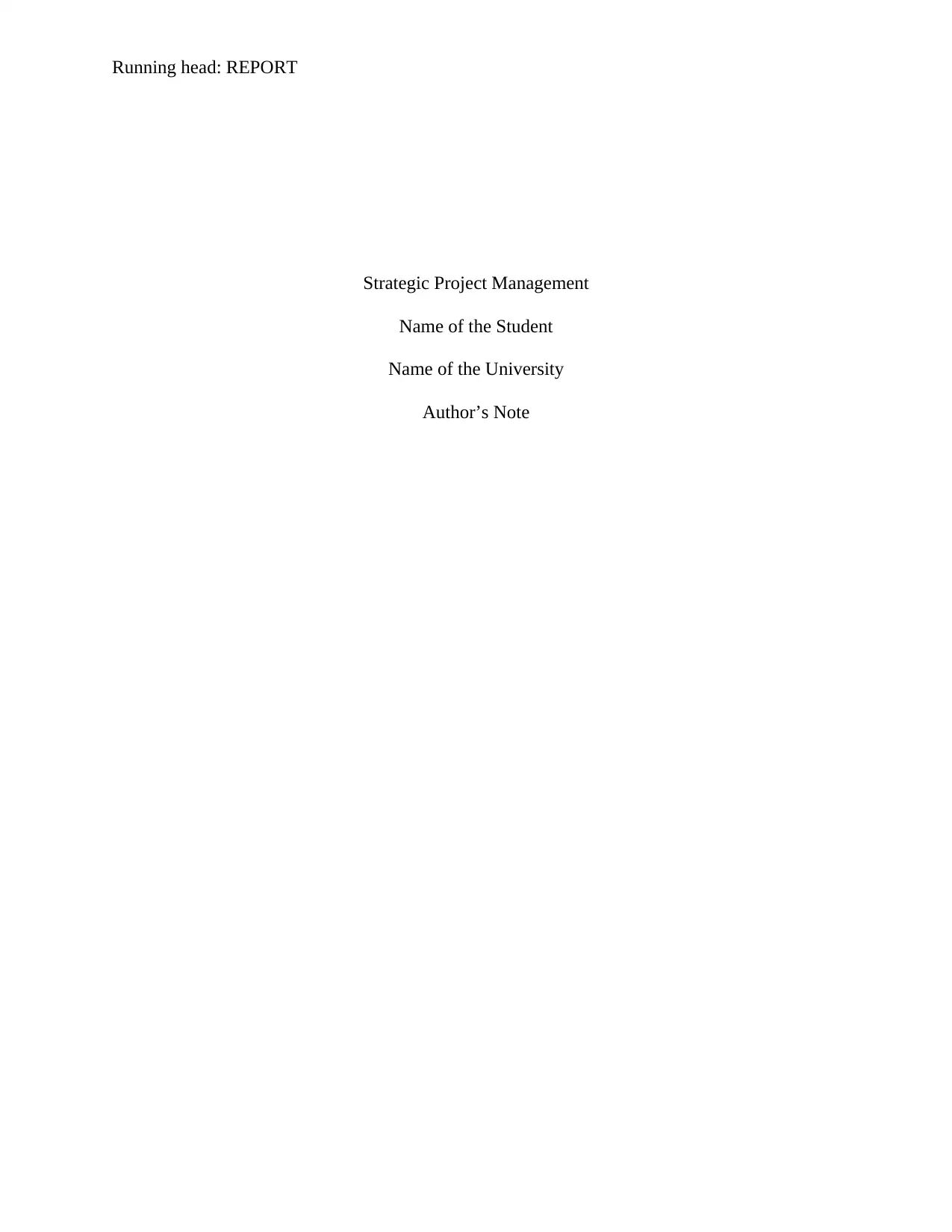
Running head: REPORT
Strategic Project Management
Name of the Student
Name of the University
Author’s Note
Strategic Project Management
Name of the Student
Name of the University
Author’s Note
Paraphrase This Document
Need a fresh take? Get an instant paraphrase of this document with our AI Paraphraser
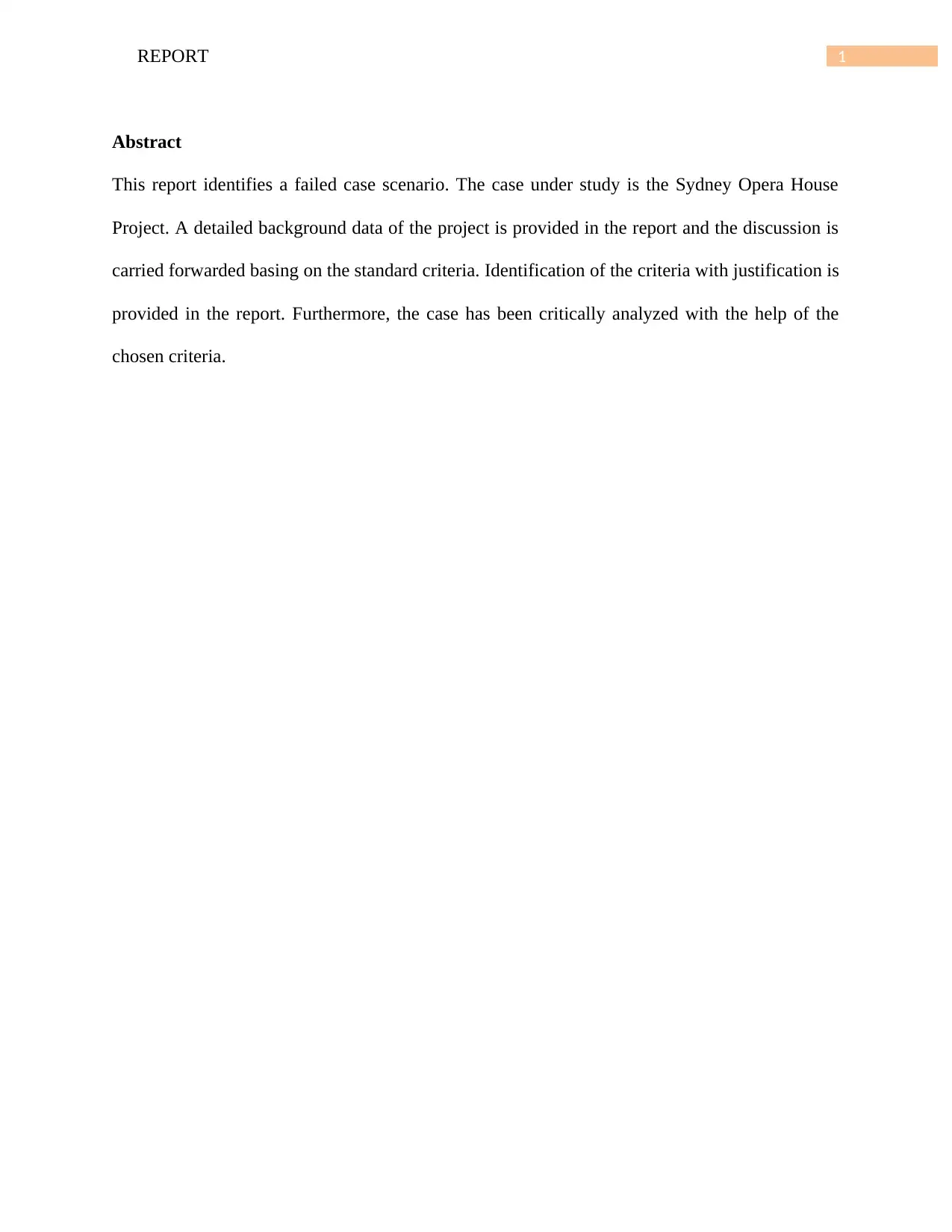
1REPORT
Abstract
This report identifies a failed case scenario. The case under study is the Sydney Opera House
Project. A detailed background data of the project is provided in the report and the discussion is
carried forwarded basing on the standard criteria. Identification of the criteria with justification is
provided in the report. Furthermore, the case has been critically analyzed with the help of the
chosen criteria.
Abstract
This report identifies a failed case scenario. The case under study is the Sydney Opera House
Project. A detailed background data of the project is provided in the report and the discussion is
carried forwarded basing on the standard criteria. Identification of the criteria with justification is
provided in the report. Furthermore, the case has been critically analyzed with the help of the
chosen criteria.
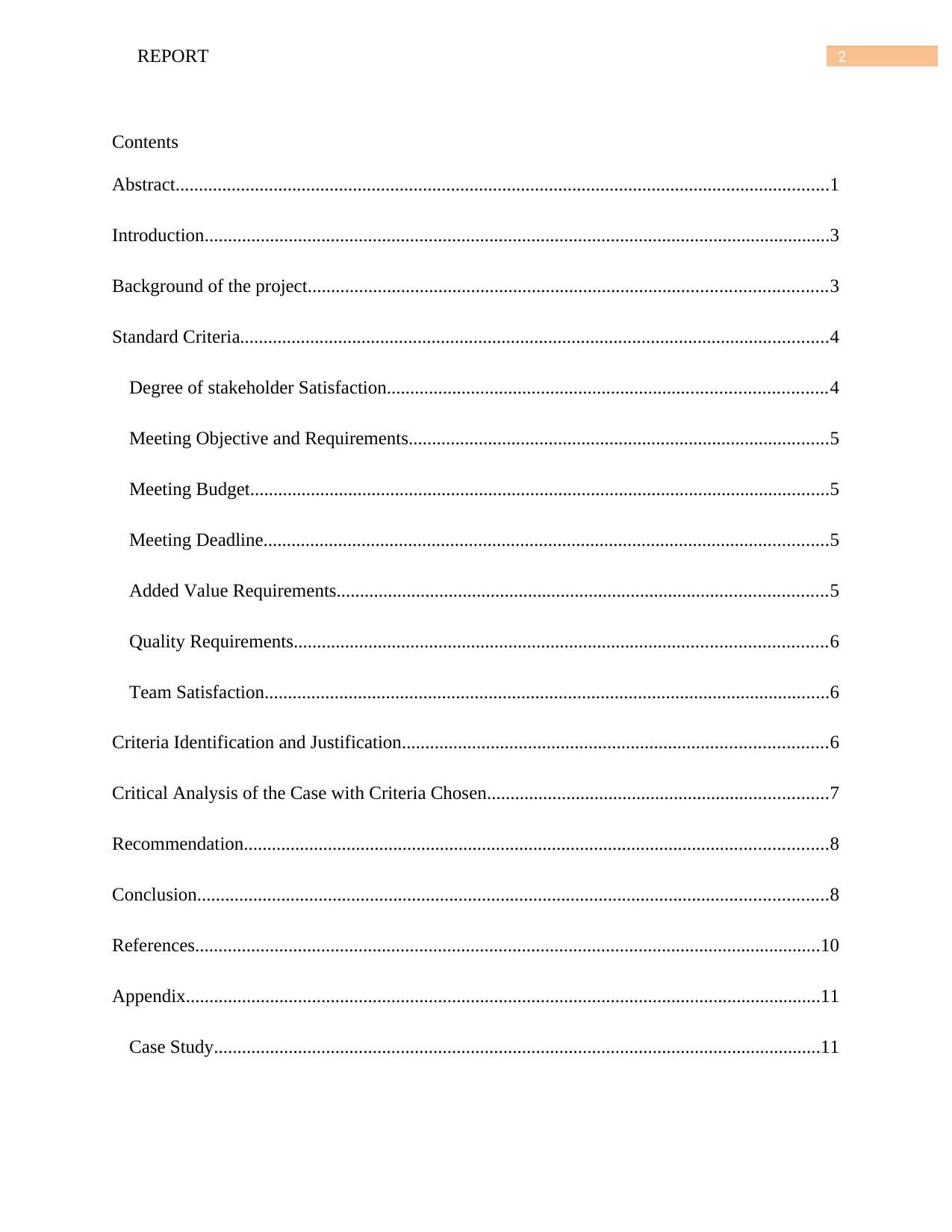
2REPORT
Contents
Abstract............................................................................................................................................1
Introduction......................................................................................................................................3
Background of the project...............................................................................................................3
Standard Criteria..............................................................................................................................4
Degree of stakeholder Satisfaction..............................................................................................4
Meeting Objective and Requirements..........................................................................................5
Meeting Budget............................................................................................................................5
Meeting Deadline.........................................................................................................................5
Added Value Requirements.........................................................................................................5
Quality Requirements..................................................................................................................6
Team Satisfaction.........................................................................................................................6
Criteria Identification and Justification...........................................................................................6
Critical Analysis of the Case with Criteria Chosen.........................................................................7
Recommendation.............................................................................................................................8
Conclusion.......................................................................................................................................8
References......................................................................................................................................10
Appendix........................................................................................................................................11
Case Study..................................................................................................................................11
Contents
Abstract............................................................................................................................................1
Introduction......................................................................................................................................3
Background of the project...............................................................................................................3
Standard Criteria..............................................................................................................................4
Degree of stakeholder Satisfaction..............................................................................................4
Meeting Objective and Requirements..........................................................................................5
Meeting Budget............................................................................................................................5
Meeting Deadline.........................................................................................................................5
Added Value Requirements.........................................................................................................5
Quality Requirements..................................................................................................................6
Team Satisfaction.........................................................................................................................6
Criteria Identification and Justification...........................................................................................6
Critical Analysis of the Case with Criteria Chosen.........................................................................7
Recommendation.............................................................................................................................8
Conclusion.......................................................................................................................................8
References......................................................................................................................................10
Appendix........................................................................................................................................11
Case Study..................................................................................................................................11
⊘ This is a preview!⊘
Do you want full access?
Subscribe today to unlock all pages.

Trusted by 1+ million students worldwide
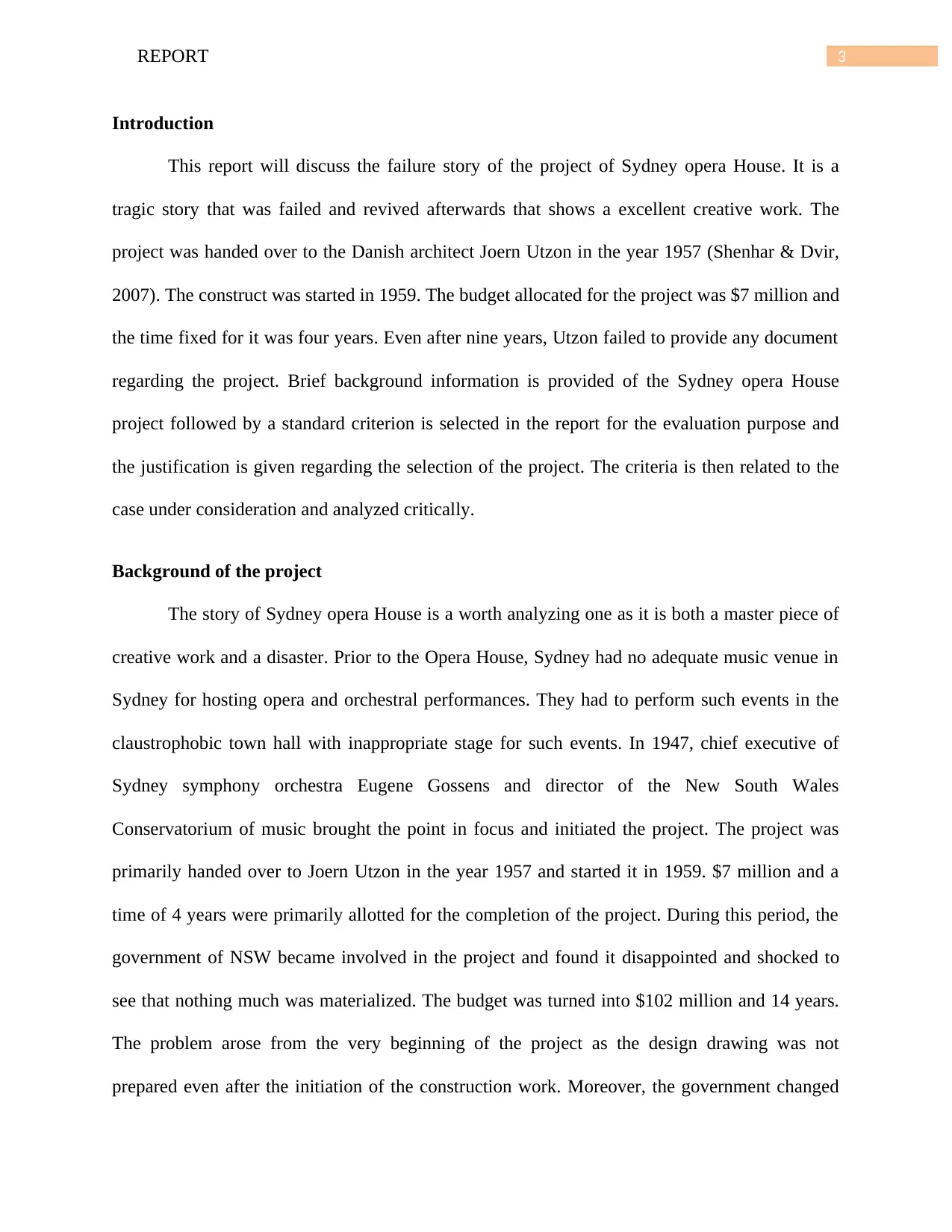
3REPORT
Introduction
This report will discuss the failure story of the project of Sydney opera House. It is a
tragic story that was failed and revived afterwards that shows a excellent creative work. The
project was handed over to the Danish architect Joern Utzon in the year 1957 (Shenhar & Dvir,
2007). The construct was started in 1959. The budget allocated for the project was $7 million and
the time fixed for it was four years. Even after nine years, Utzon failed to provide any document
regarding the project. Brief background information is provided of the Sydney opera House
project followed by a standard criterion is selected in the report for the evaluation purpose and
the justification is given regarding the selection of the project. The criteria is then related to the
case under consideration and analyzed critically.
Background of the project
The story of Sydney opera House is a worth analyzing one as it is both a master piece of
creative work and a disaster. Prior to the Opera House, Sydney had no adequate music venue in
Sydney for hosting opera and orchestral performances. They had to perform such events in the
claustrophobic town hall with inappropriate stage for such events. In 1947, chief executive of
Sydney symphony orchestra Eugene Gossens and director of the New South Wales
Conservatorium of music brought the point in focus and initiated the project. The project was
primarily handed over to Joern Utzon in the year 1957 and started it in 1959. $7 million and a
time of 4 years were primarily allotted for the completion of the project. During this period, the
government of NSW became involved in the project and found it disappointed and shocked to
see that nothing much was materialized. The budget was turned into $102 million and 14 years.
The problem arose from the very beginning of the project as the design drawing was not
prepared even after the initiation of the construction work. Moreover, the government changed
Introduction
This report will discuss the failure story of the project of Sydney opera House. It is a
tragic story that was failed and revived afterwards that shows a excellent creative work. The
project was handed over to the Danish architect Joern Utzon in the year 1957 (Shenhar & Dvir,
2007). The construct was started in 1959. The budget allocated for the project was $7 million and
the time fixed for it was four years. Even after nine years, Utzon failed to provide any document
regarding the project. Brief background information is provided of the Sydney opera House
project followed by a standard criterion is selected in the report for the evaluation purpose and
the justification is given regarding the selection of the project. The criteria is then related to the
case under consideration and analyzed critically.
Background of the project
The story of Sydney opera House is a worth analyzing one as it is both a master piece of
creative work and a disaster. Prior to the Opera House, Sydney had no adequate music venue in
Sydney for hosting opera and orchestral performances. They had to perform such events in the
claustrophobic town hall with inappropriate stage for such events. In 1947, chief executive of
Sydney symphony orchestra Eugene Gossens and director of the New South Wales
Conservatorium of music brought the point in focus and initiated the project. The project was
primarily handed over to Joern Utzon in the year 1957 and started it in 1959. $7 million and a
time of 4 years were primarily allotted for the completion of the project. During this period, the
government of NSW became involved in the project and found it disappointed and shocked to
see that nothing much was materialized. The budget was turned into $102 million and 14 years.
The problem arose from the very beginning of the project as the design drawing was not
prepared even after the initiation of the construction work. Moreover, the government changed
Paraphrase This Document
Need a fresh take? Get an instant paraphrase of this document with our AI Paraphraser
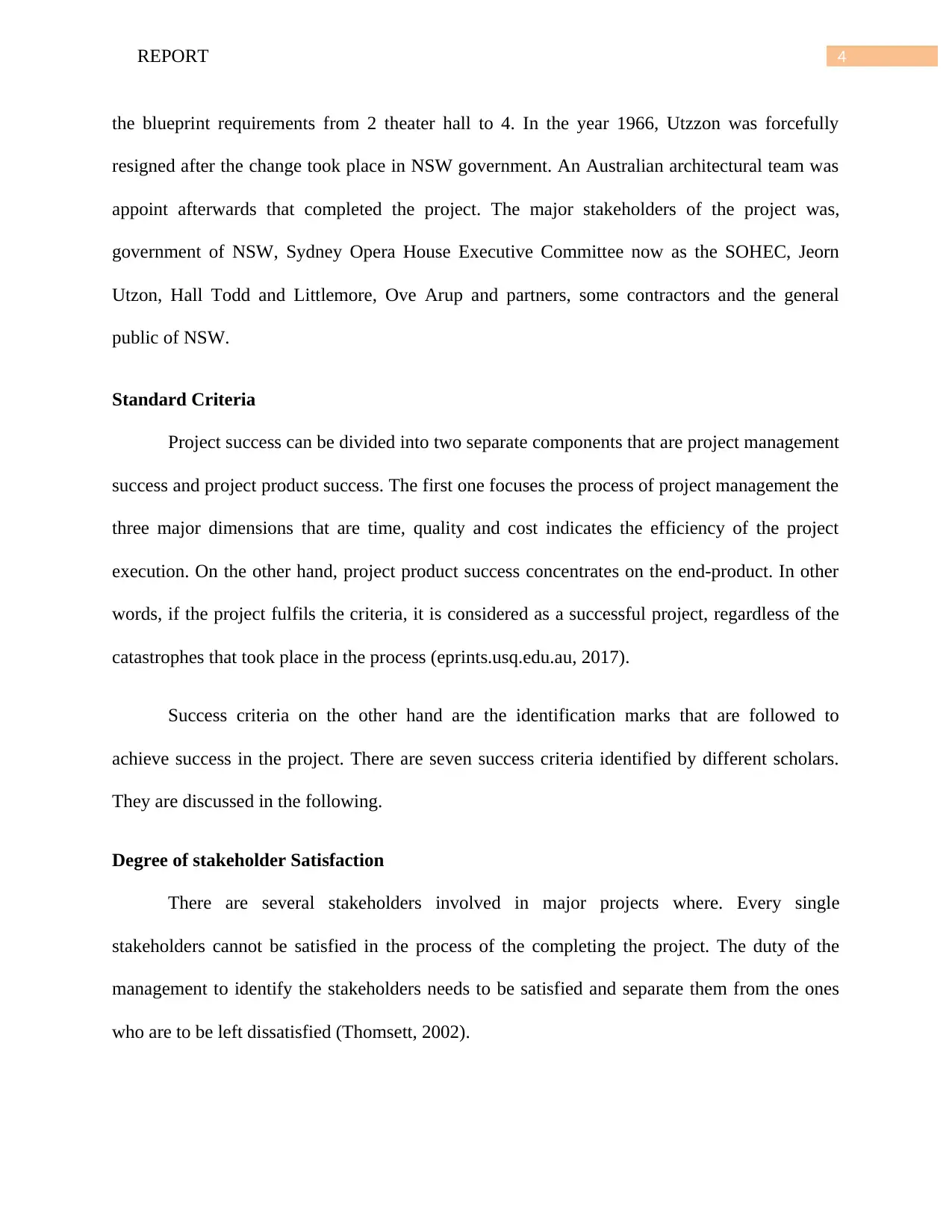
4REPORT
the blueprint requirements from 2 theater hall to 4. In the year 1966, Utzzon was forcefully
resigned after the change took place in NSW government. An Australian architectural team was
appoint afterwards that completed the project. The major stakeholders of the project was,
government of NSW, Sydney Opera House Executive Committee now as the SOHEC, Jeorn
Utzon, Hall Todd and Littlemore, Ove Arup and partners, some contractors and the general
public of NSW.
Standard Criteria
Project success can be divided into two separate components that are project management
success and project product success. The first one focuses the process of project management the
three major dimensions that are time, quality and cost indicates the efficiency of the project
execution. On the other hand, project product success concentrates on the end-product. In other
words, if the project fulfils the criteria, it is considered as a successful project, regardless of the
catastrophes that took place in the process (eprints.usq.edu.au, 2017).
Success criteria on the other hand are the identification marks that are followed to
achieve success in the project. There are seven success criteria identified by different scholars.
They are discussed in the following.
Degree of stakeholder Satisfaction
There are several stakeholders involved in major projects where. Every single
stakeholders cannot be satisfied in the process of the completing the project. The duty of the
management to identify the stakeholders needs to be satisfied and separate them from the ones
who are to be left dissatisfied (Thomsett, 2002).
the blueprint requirements from 2 theater hall to 4. In the year 1966, Utzzon was forcefully
resigned after the change took place in NSW government. An Australian architectural team was
appoint afterwards that completed the project. The major stakeholders of the project was,
government of NSW, Sydney Opera House Executive Committee now as the SOHEC, Jeorn
Utzon, Hall Todd and Littlemore, Ove Arup and partners, some contractors and the general
public of NSW.
Standard Criteria
Project success can be divided into two separate components that are project management
success and project product success. The first one focuses the process of project management the
three major dimensions that are time, quality and cost indicates the efficiency of the project
execution. On the other hand, project product success concentrates on the end-product. In other
words, if the project fulfils the criteria, it is considered as a successful project, regardless of the
catastrophes that took place in the process (eprints.usq.edu.au, 2017).
Success criteria on the other hand are the identification marks that are followed to
achieve success in the project. There are seven success criteria identified by different scholars.
They are discussed in the following.
Degree of stakeholder Satisfaction
There are several stakeholders involved in major projects where. Every single
stakeholders cannot be satisfied in the process of the completing the project. The duty of the
management to identify the stakeholders needs to be satisfied and separate them from the ones
who are to be left dissatisfied (Thomsett, 2002).
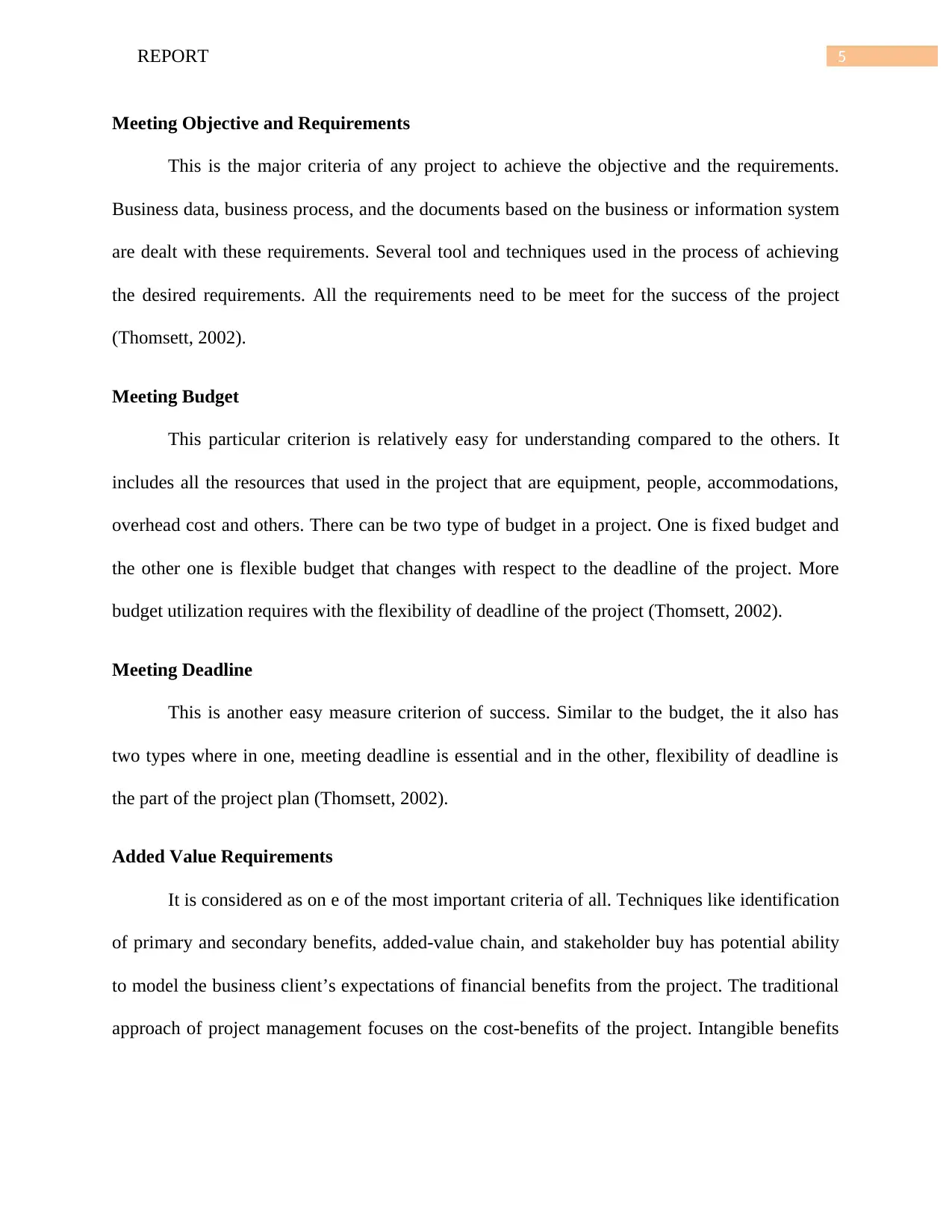
5REPORT
Meeting Objective and Requirements
This is the major criteria of any project to achieve the objective and the requirements.
Business data, business process, and the documents based on the business or information system
are dealt with these requirements. Several tool and techniques used in the process of achieving
the desired requirements. All the requirements need to be meet for the success of the project
(Thomsett, 2002).
Meeting Budget
This particular criterion is relatively easy for understanding compared to the others. It
includes all the resources that used in the project that are equipment, people, accommodations,
overhead cost and others. There can be two type of budget in a project. One is fixed budget and
the other one is flexible budget that changes with respect to the deadline of the project. More
budget utilization requires with the flexibility of deadline of the project (Thomsett, 2002).
Meeting Deadline
This is another easy measure criterion of success. Similar to the budget, the it also has
two types where in one, meeting deadline is essential and in the other, flexibility of deadline is
the part of the project plan (Thomsett, 2002).
Added Value Requirements
It is considered as on e of the most important criteria of all. Techniques like identification
of primary and secondary benefits, added-value chain, and stakeholder buy has potential ability
to model the business client’s expectations of financial benefits from the project. The traditional
approach of project management focuses on the cost-benefits of the project. Intangible benefits
Meeting Objective and Requirements
This is the major criteria of any project to achieve the objective and the requirements.
Business data, business process, and the documents based on the business or information system
are dealt with these requirements. Several tool and techniques used in the process of achieving
the desired requirements. All the requirements need to be meet for the success of the project
(Thomsett, 2002).
Meeting Budget
This particular criterion is relatively easy for understanding compared to the others. It
includes all the resources that used in the project that are equipment, people, accommodations,
overhead cost and others. There can be two type of budget in a project. One is fixed budget and
the other one is flexible budget that changes with respect to the deadline of the project. More
budget utilization requires with the flexibility of deadline of the project (Thomsett, 2002).
Meeting Deadline
This is another easy measure criterion of success. Similar to the budget, the it also has
two types where in one, meeting deadline is essential and in the other, flexibility of deadline is
the part of the project plan (Thomsett, 2002).
Added Value Requirements
It is considered as on e of the most important criteria of all. Techniques like identification
of primary and secondary benefits, added-value chain, and stakeholder buy has potential ability
to model the business client’s expectations of financial benefits from the project. The traditional
approach of project management focuses on the cost-benefits of the project. Intangible benefits
⊘ This is a preview!⊘
Do you want full access?
Subscribe today to unlock all pages.

Trusted by 1+ million students worldwide
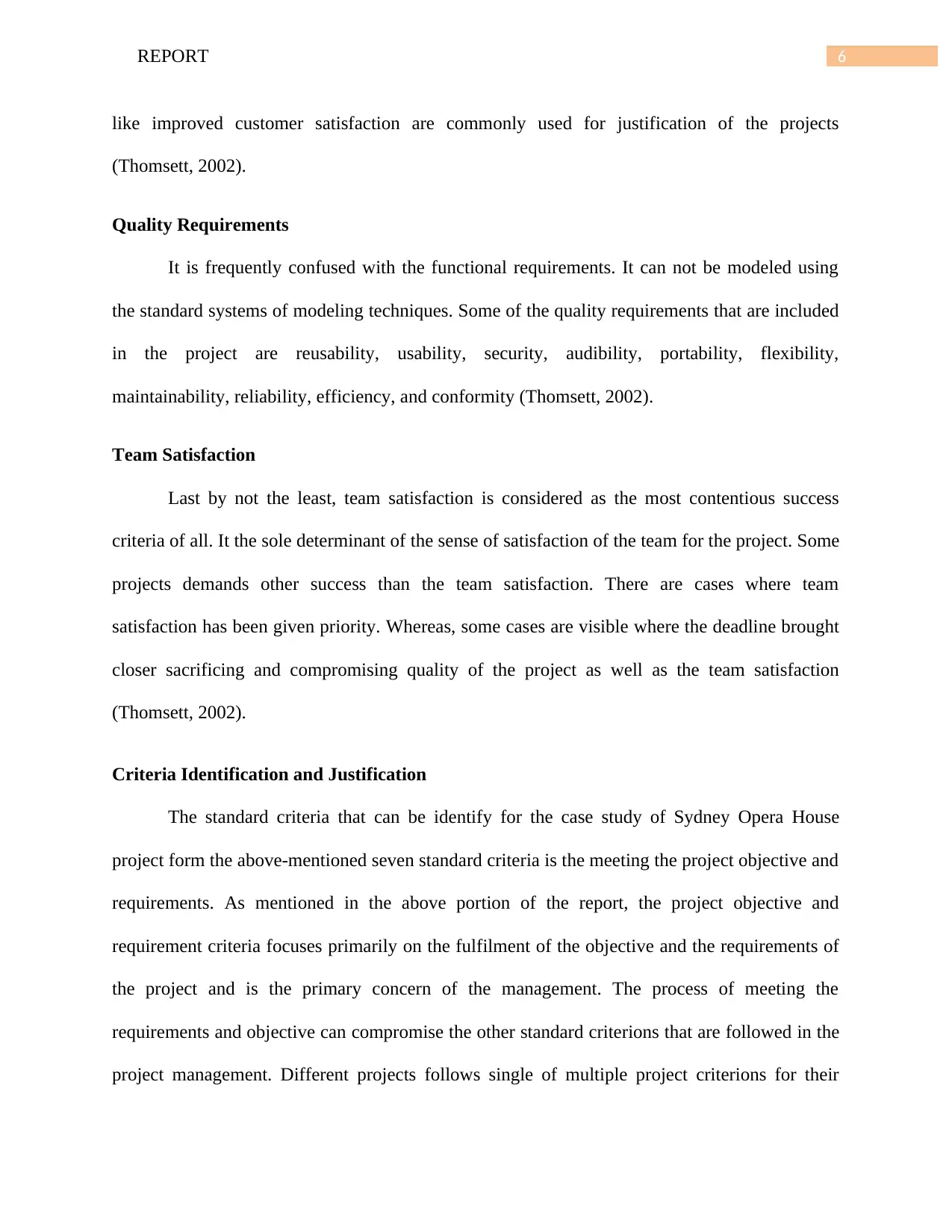
6REPORT
like improved customer satisfaction are commonly used for justification of the projects
(Thomsett, 2002).
Quality Requirements
It is frequently confused with the functional requirements. It can not be modeled using
the standard systems of modeling techniques. Some of the quality requirements that are included
in the project are reusability, usability, security, audibility, portability, flexibility,
maintainability, reliability, efficiency, and conformity (Thomsett, 2002).
Team Satisfaction
Last by not the least, team satisfaction is considered as the most contentious success
criteria of all. It the sole determinant of the sense of satisfaction of the team for the project. Some
projects demands other success than the team satisfaction. There are cases where team
satisfaction has been given priority. Whereas, some cases are visible where the deadline brought
closer sacrificing and compromising quality of the project as well as the team satisfaction
(Thomsett, 2002).
Criteria Identification and Justification
The standard criteria that can be identify for the case study of Sydney Opera House
project form the above-mentioned seven standard criteria is the meeting the project objective and
requirements. As mentioned in the above portion of the report, the project objective and
requirement criteria focuses primarily on the fulfilment of the objective and the requirements of
the project and is the primary concern of the management. The process of meeting the
requirements and objective can compromise the other standard criterions that are followed in the
project management. Different projects follows single of multiple project criterions for their
like improved customer satisfaction are commonly used for justification of the projects
(Thomsett, 2002).
Quality Requirements
It is frequently confused with the functional requirements. It can not be modeled using
the standard systems of modeling techniques. Some of the quality requirements that are included
in the project are reusability, usability, security, audibility, portability, flexibility,
maintainability, reliability, efficiency, and conformity (Thomsett, 2002).
Team Satisfaction
Last by not the least, team satisfaction is considered as the most contentious success
criteria of all. It the sole determinant of the sense of satisfaction of the team for the project. Some
projects demands other success than the team satisfaction. There are cases where team
satisfaction has been given priority. Whereas, some cases are visible where the deadline brought
closer sacrificing and compromising quality of the project as well as the team satisfaction
(Thomsett, 2002).
Criteria Identification and Justification
The standard criteria that can be identify for the case study of Sydney Opera House
project form the above-mentioned seven standard criteria is the meeting the project objective and
requirements. As mentioned in the above portion of the report, the project objective and
requirement criteria focuses primarily on the fulfilment of the objective and the requirements of
the project and is the primary concern of the management. The process of meeting the
requirements and objective can compromise the other standard criterions that are followed in the
project management. Different projects follows single of multiple project criterions for their
Paraphrase This Document
Need a fresh take? Get an instant paraphrase of this document with our AI Paraphraser
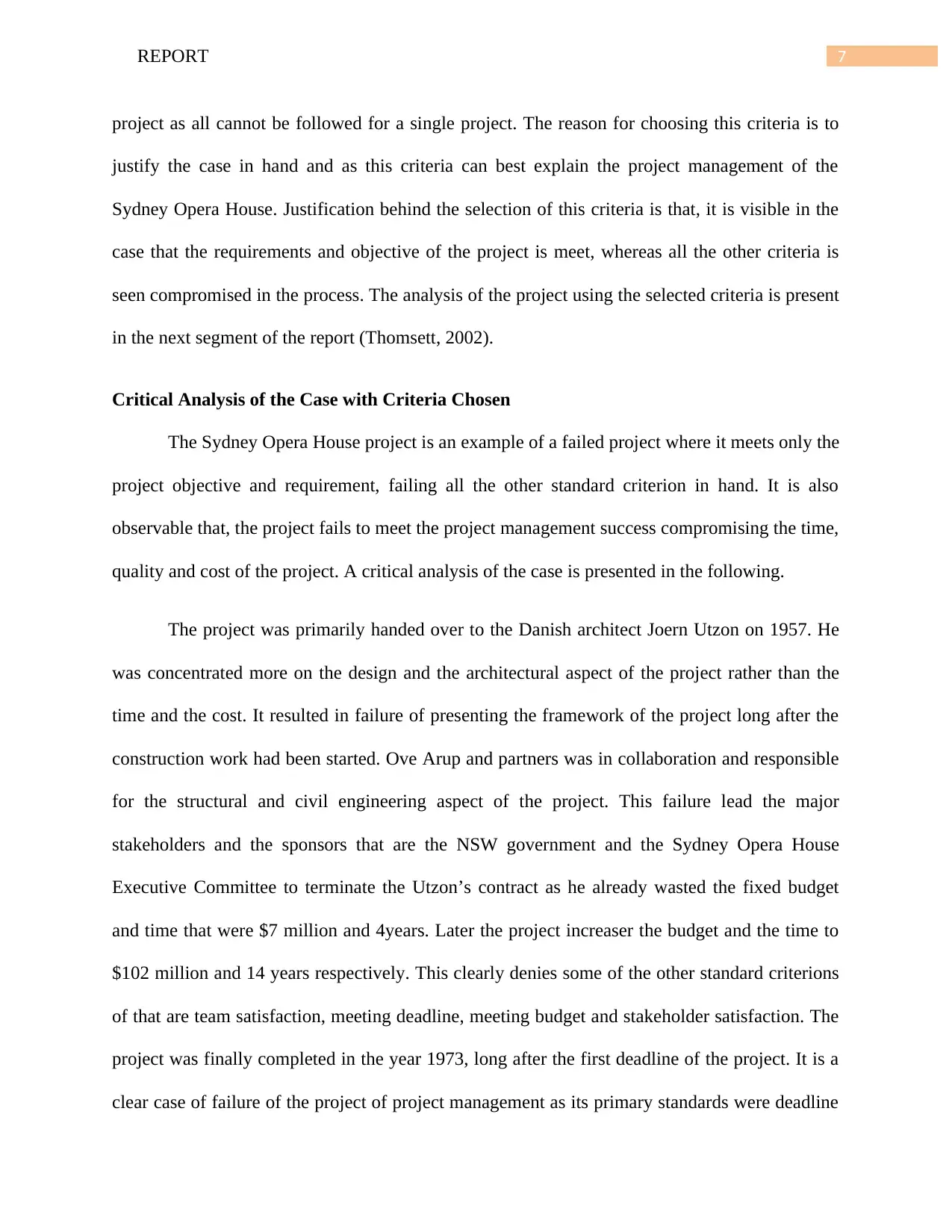
7REPORT
project as all cannot be followed for a single project. The reason for choosing this criteria is to
justify the case in hand and as this criteria can best explain the project management of the
Sydney Opera House. Justification behind the selection of this criteria is that, it is visible in the
case that the requirements and objective of the project is meet, whereas all the other criteria is
seen compromised in the process. The analysis of the project using the selected criteria is present
in the next segment of the report (Thomsett, 2002).
Critical Analysis of the Case with Criteria Chosen
The Sydney Opera House project is an example of a failed project where it meets only the
project objective and requirement, failing all the other standard criterion in hand. It is also
observable that, the project fails to meet the project management success compromising the time,
quality and cost of the project. A critical analysis of the case is presented in the following.
The project was primarily handed over to the Danish architect Joern Utzon on 1957. He
was concentrated more on the design and the architectural aspect of the project rather than the
time and the cost. It resulted in failure of presenting the framework of the project long after the
construction work had been started. Ove Arup and partners was in collaboration and responsible
for the structural and civil engineering aspect of the project. This failure lead the major
stakeholders and the sponsors that are the NSW government and the Sydney Opera House
Executive Committee to terminate the Utzon’s contract as he already wasted the fixed budget
and time that were $7 million and 4years. Later the project increaser the budget and the time to
$102 million and 14 years respectively. This clearly denies some of the other standard criterions
of that are team satisfaction, meeting deadline, meeting budget and stakeholder satisfaction. The
project was finally completed in the year 1973, long after the first deadline of the project. It is a
clear case of failure of the project of project management as its primary standards were deadline
project as all cannot be followed for a single project. The reason for choosing this criteria is to
justify the case in hand and as this criteria can best explain the project management of the
Sydney Opera House. Justification behind the selection of this criteria is that, it is visible in the
case that the requirements and objective of the project is meet, whereas all the other criteria is
seen compromised in the process. The analysis of the project using the selected criteria is present
in the next segment of the report (Thomsett, 2002).
Critical Analysis of the Case with Criteria Chosen
The Sydney Opera House project is an example of a failed project where it meets only the
project objective and requirement, failing all the other standard criterion in hand. It is also
observable that, the project fails to meet the project management success compromising the time,
quality and cost of the project. A critical analysis of the case is presented in the following.
The project was primarily handed over to the Danish architect Joern Utzon on 1957. He
was concentrated more on the design and the architectural aspect of the project rather than the
time and the cost. It resulted in failure of presenting the framework of the project long after the
construction work had been started. Ove Arup and partners was in collaboration and responsible
for the structural and civil engineering aspect of the project. This failure lead the major
stakeholders and the sponsors that are the NSW government and the Sydney Opera House
Executive Committee to terminate the Utzon’s contract as he already wasted the fixed budget
and time that were $7 million and 4years. Later the project increaser the budget and the time to
$102 million and 14 years respectively. This clearly denies some of the other standard criterions
of that are team satisfaction, meeting deadline, meeting budget and stakeholder satisfaction. The
project was finally completed in the year 1973, long after the first deadline of the project. It is a
clear case of failure of the project of project management as its primary standards were deadline
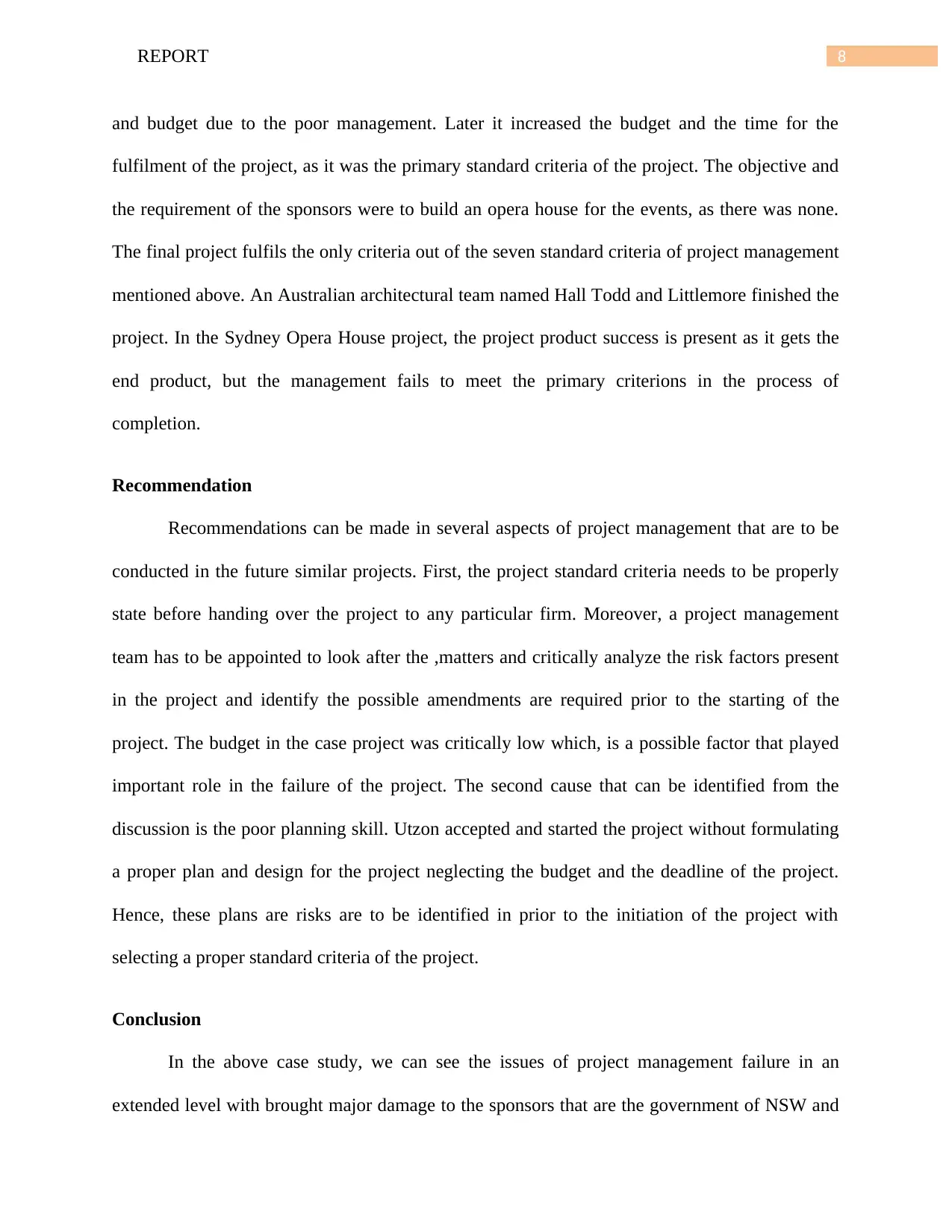
8REPORT
and budget due to the poor management. Later it increased the budget and the time for the
fulfilment of the project, as it was the primary standard criteria of the project. The objective and
the requirement of the sponsors were to build an opera house for the events, as there was none.
The final project fulfils the only criteria out of the seven standard criteria of project management
mentioned above. An Australian architectural team named Hall Todd and Littlemore finished the
project. In the Sydney Opera House project, the project product success is present as it gets the
end product, but the management fails to meet the primary criterions in the process of
completion.
Recommendation
Recommendations can be made in several aspects of project management that are to be
conducted in the future similar projects. First, the project standard criteria needs to be properly
state before handing over the project to any particular firm. Moreover, a project management
team has to be appointed to look after the ,matters and critically analyze the risk factors present
in the project and identify the possible amendments are required prior to the starting of the
project. The budget in the case project was critically low which, is a possible factor that played
important role in the failure of the project. The second cause that can be identified from the
discussion is the poor planning skill. Utzon accepted and started the project without formulating
a proper plan and design for the project neglecting the budget and the deadline of the project.
Hence, these plans are risks are to be identified in prior to the initiation of the project with
selecting a proper standard criteria of the project.
Conclusion
In the above case study, we can see the issues of project management failure in an
extended level with brought major damage to the sponsors that are the government of NSW and
and budget due to the poor management. Later it increased the budget and the time for the
fulfilment of the project, as it was the primary standard criteria of the project. The objective and
the requirement of the sponsors were to build an opera house for the events, as there was none.
The final project fulfils the only criteria out of the seven standard criteria of project management
mentioned above. An Australian architectural team named Hall Todd and Littlemore finished the
project. In the Sydney Opera House project, the project product success is present as it gets the
end product, but the management fails to meet the primary criterions in the process of
completion.
Recommendation
Recommendations can be made in several aspects of project management that are to be
conducted in the future similar projects. First, the project standard criteria needs to be properly
state before handing over the project to any particular firm. Moreover, a project management
team has to be appointed to look after the ,matters and critically analyze the risk factors present
in the project and identify the possible amendments are required prior to the starting of the
project. The budget in the case project was critically low which, is a possible factor that played
important role in the failure of the project. The second cause that can be identified from the
discussion is the poor planning skill. Utzon accepted and started the project without formulating
a proper plan and design for the project neglecting the budget and the deadline of the project.
Hence, these plans are risks are to be identified in prior to the initiation of the project with
selecting a proper standard criteria of the project.
Conclusion
In the above case study, we can see the issues of project management failure in an
extended level with brought major damage to the sponsors that are the government of NSW and
⊘ This is a preview!⊘
Do you want full access?
Subscribe today to unlock all pages.

Trusted by 1+ million students worldwide
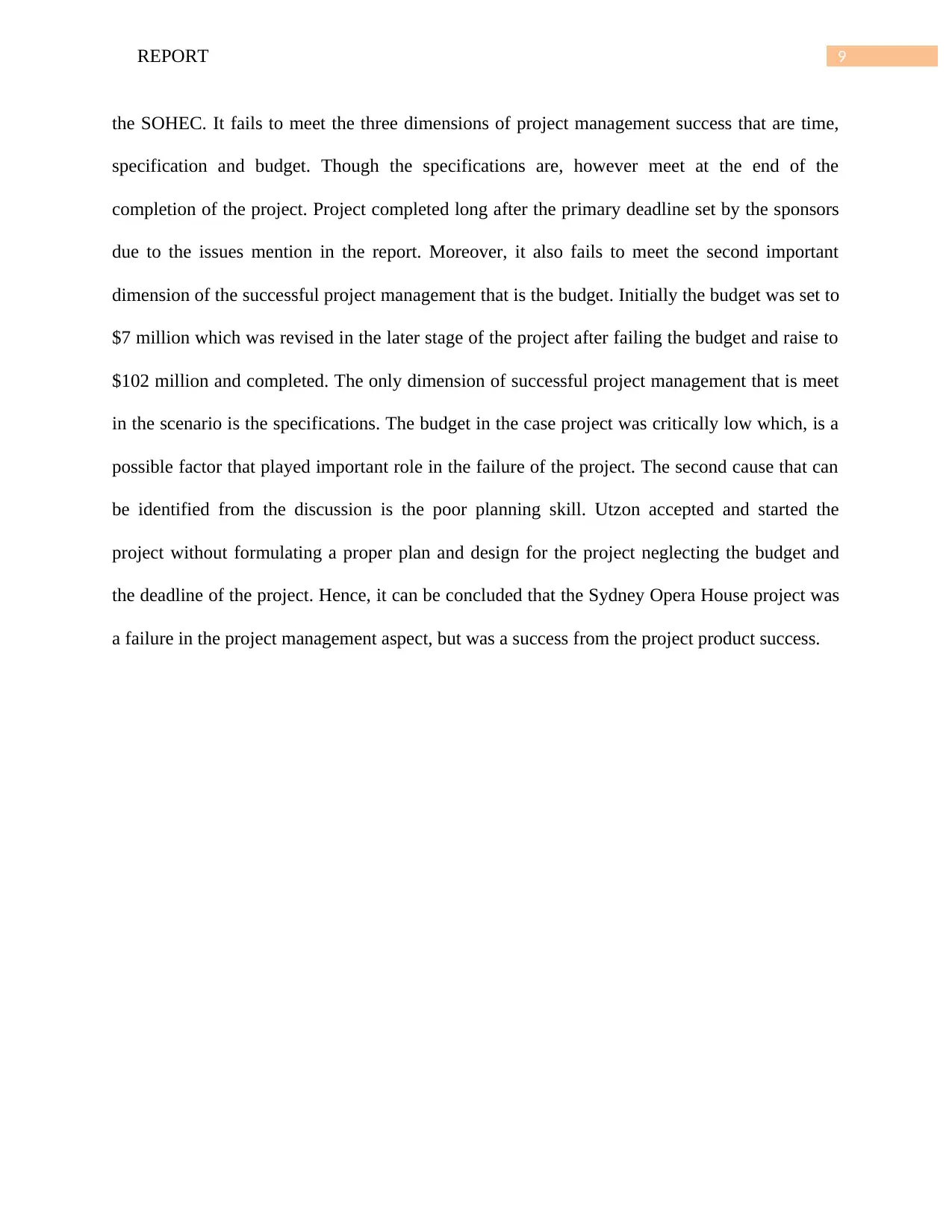
9REPORT
the SOHEC. It fails to meet the three dimensions of project management success that are time,
specification and budget. Though the specifications are, however meet at the end of the
completion of the project. Project completed long after the primary deadline set by the sponsors
due to the issues mention in the report. Moreover, it also fails to meet the second important
dimension of the successful project management that is the budget. Initially the budget was set to
$7 million which was revised in the later stage of the project after failing the budget and raise to
$102 million and completed. The only dimension of successful project management that is meet
in the scenario is the specifications. The budget in the case project was critically low which, is a
possible factor that played important role in the failure of the project. The second cause that can
be identified from the discussion is the poor planning skill. Utzon accepted and started the
project without formulating a proper plan and design for the project neglecting the budget and
the deadline of the project. Hence, it can be concluded that the Sydney Opera House project was
a failure in the project management aspect, but was a success from the project product success.
the SOHEC. It fails to meet the three dimensions of project management success that are time,
specification and budget. Though the specifications are, however meet at the end of the
completion of the project. Project completed long after the primary deadline set by the sponsors
due to the issues mention in the report. Moreover, it also fails to meet the second important
dimension of the successful project management that is the budget. Initially the budget was set to
$7 million which was revised in the later stage of the project after failing the budget and raise to
$102 million and completed. The only dimension of successful project management that is meet
in the scenario is the specifications. The budget in the case project was critically low which, is a
possible factor that played important role in the failure of the project. The second cause that can
be identified from the discussion is the poor planning skill. Utzon accepted and started the
project without formulating a proper plan and design for the project neglecting the budget and
the deadline of the project. Hence, it can be concluded that the Sydney Opera House project was
a failure in the project management aspect, but was a success from the project product success.
Paraphrase This Document
Need a fresh take? Get an instant paraphrase of this document with our AI Paraphraser
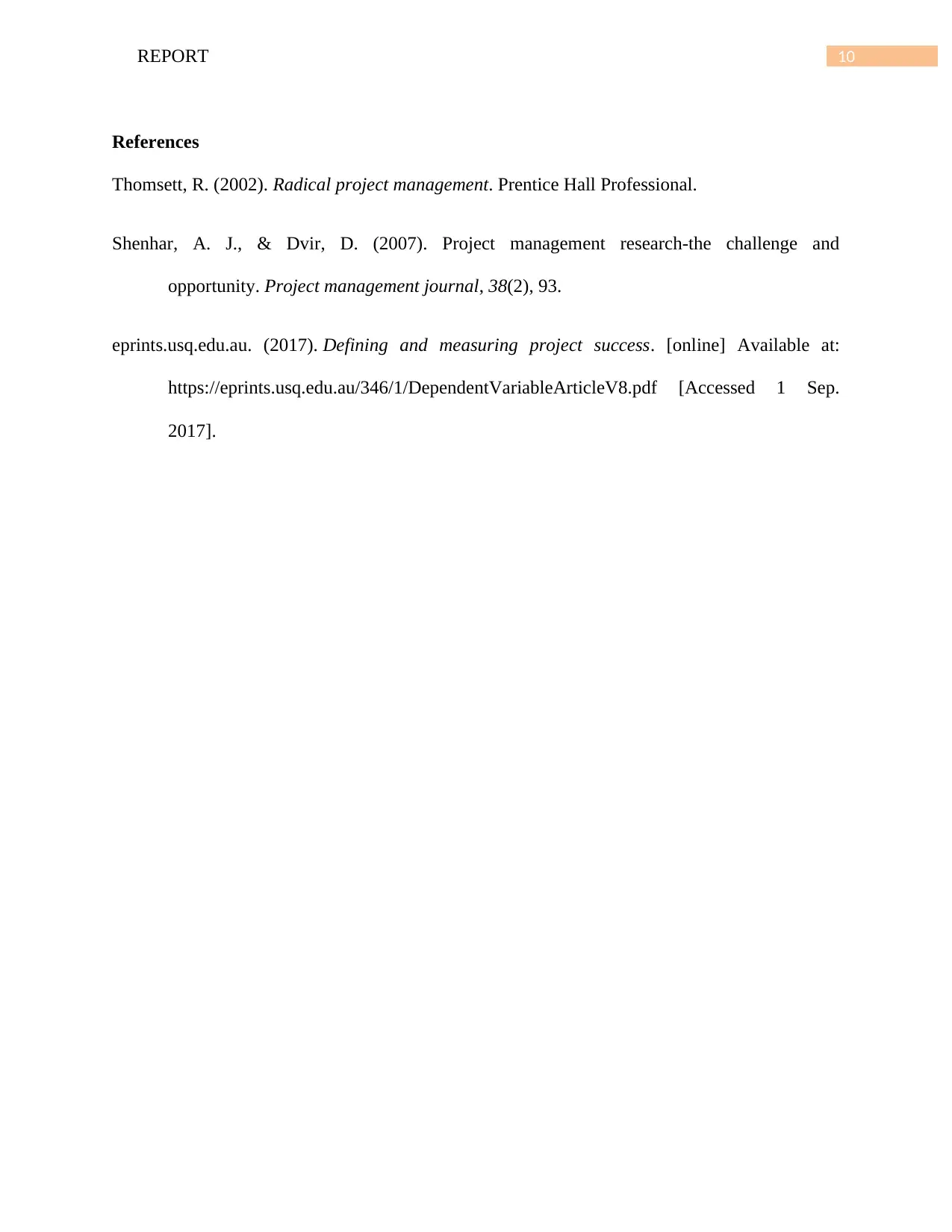
10REPORT
References
Thomsett, R. (2002). Radical project management. Prentice Hall Professional.
Shenhar, A. J., & Dvir, D. (2007). Project management research-the challenge and
opportunity. Project management journal, 38(2), 93.
eprints.usq.edu.au. (2017). Defining and measuring project success. [online] Available at:
https://eprints.usq.edu.au/346/1/DependentVariableArticleV8.pdf [Accessed 1 Sep.
2017].
References
Thomsett, R. (2002). Radical project management. Prentice Hall Professional.
Shenhar, A. J., & Dvir, D. (2007). Project management research-the challenge and
opportunity. Project management journal, 38(2), 93.
eprints.usq.edu.au. (2017). Defining and measuring project success. [online] Available at:
https://eprints.usq.edu.au/346/1/DependentVariableArticleV8.pdf [Accessed 1 Sep.
2017].
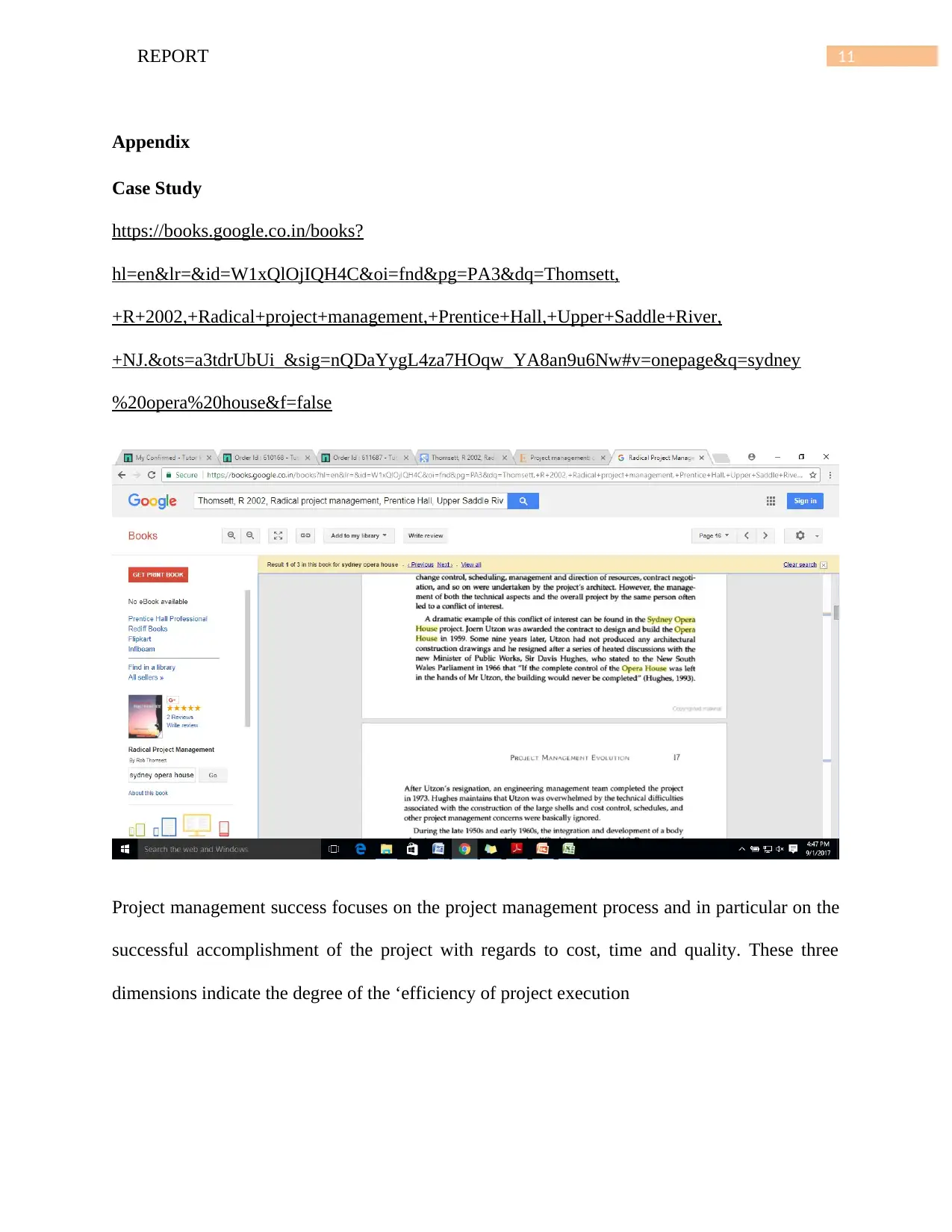
11REPORT
Appendix
Case Study
https://books.google.co.in/books?
hl=en&lr=&id=W1xQlOjIQH4C&oi=fnd&pg=PA3&dq=Thomsett,
+R+2002,+Radical+project+management,+Prentice+Hall,+Upper+Saddle+River,
+NJ.&ots=a3tdrUbUi_&sig=nQDaYygL4za7HOqw_YA8an9u6Nw#v=onepage&q=sydney
%20opera%20house&f=false
Project management success focuses on the project management process and in particular on the
successful accomplishment of the project with regards to cost, time and quality. These three
dimensions indicate the degree of the ‘efficiency of project execution
Appendix
Case Study
https://books.google.co.in/books?
hl=en&lr=&id=W1xQlOjIQH4C&oi=fnd&pg=PA3&dq=Thomsett,
+R+2002,+Radical+project+management,+Prentice+Hall,+Upper+Saddle+River,
+NJ.&ots=a3tdrUbUi_&sig=nQDaYygL4za7HOqw_YA8an9u6Nw#v=onepage&q=sydney
%20opera%20house&f=false
Project management success focuses on the project management process and in particular on the
successful accomplishment of the project with regards to cost, time and quality. These three
dimensions indicate the degree of the ‘efficiency of project execution
⊘ This is a preview!⊘
Do you want full access?
Subscribe today to unlock all pages.

Trusted by 1+ million students worldwide
1 out of 13
Related Documents
Your All-in-One AI-Powered Toolkit for Academic Success.
+13062052269
info@desklib.com
Available 24*7 on WhatsApp / Email
![[object Object]](/_next/static/media/star-bottom.7253800d.svg)
Unlock your academic potential
Copyright © 2020–2025 A2Z Services. All Rights Reserved. Developed and managed by ZUCOL.




